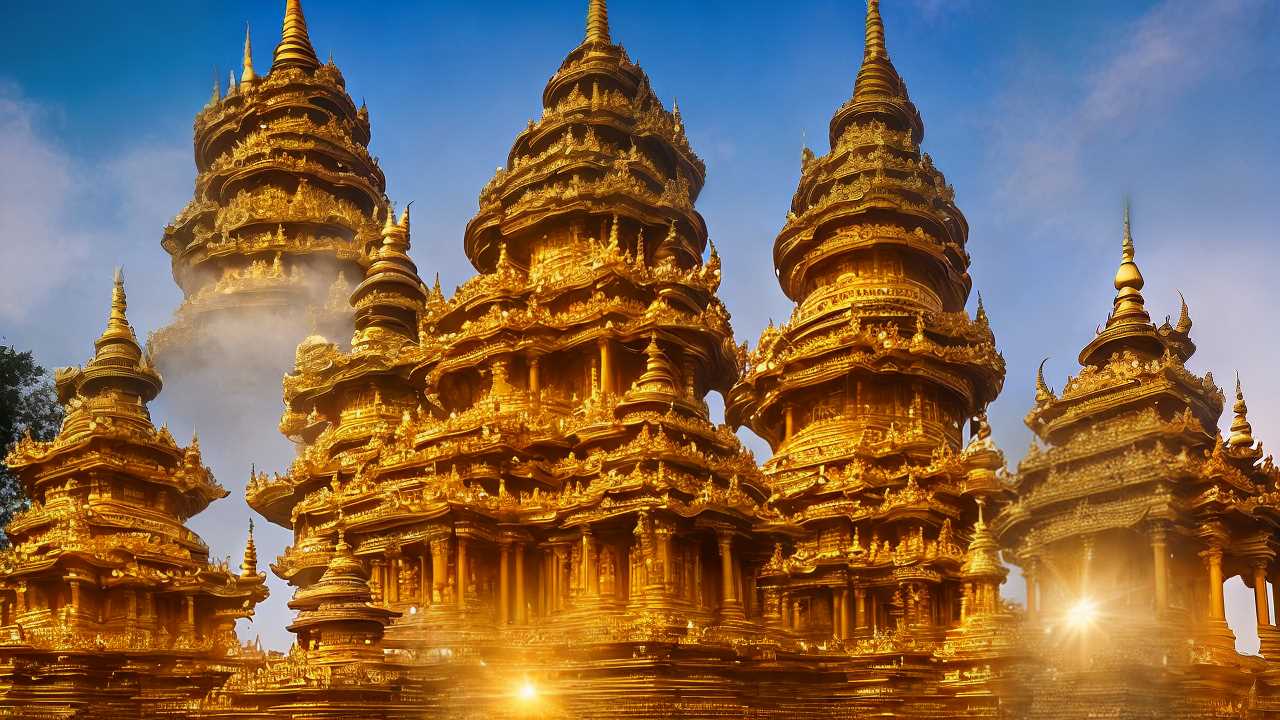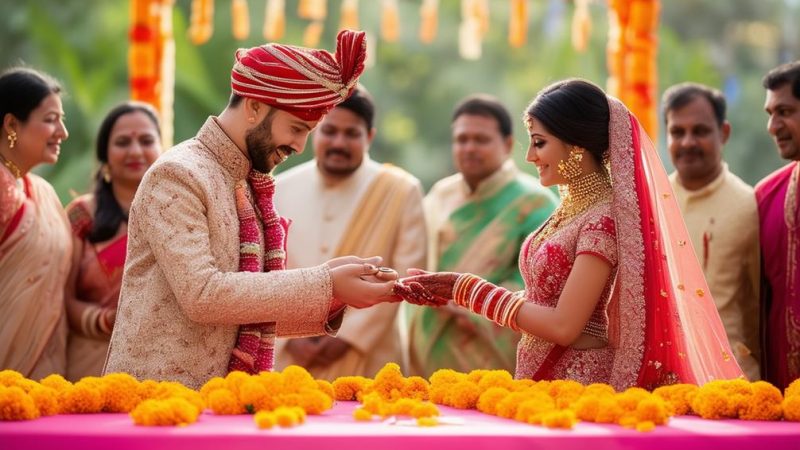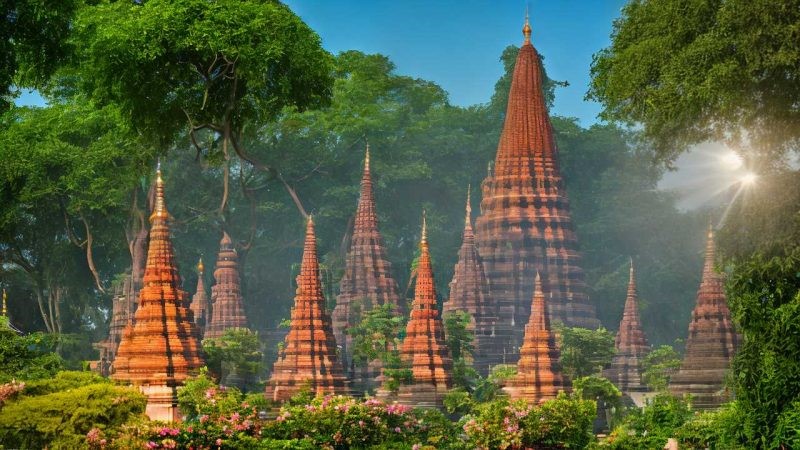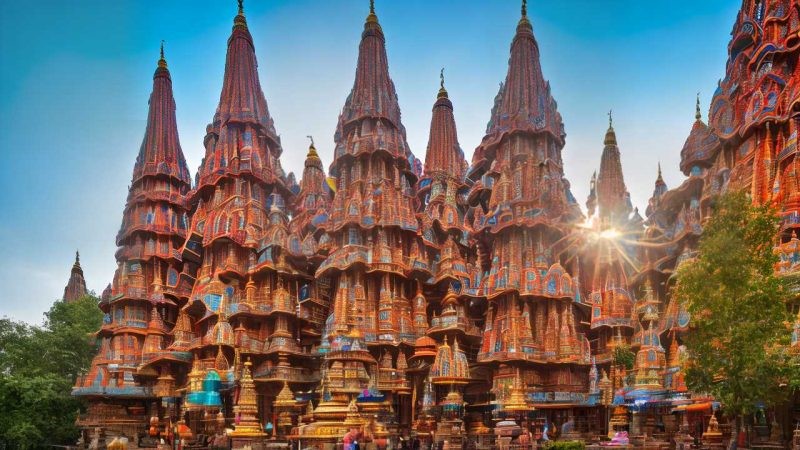The Aesthetic Foundations of Hindu Mythology

Hindu mythology is much more than just stories about gods and goddesses. It’s a complex mix of sights, sounds, and meanings that affects all the senses. The symbols used in Hindu art, like the features and items associated with each god, are full of hidden meanings. Colors aren’t just used for decoration; they represent deep ideas and feelings.
Hindu temples are impressive not just because they are big and complex, but because they show important cosmic ideas and tell the stories of the gods in their design and structure.
Understanding this deep connection between art and spirituality in Hinduism is crucial. It’s seen in cultural performances and daily religious practices. This blend of beauty and belief is something we should look into more deeply. It shows us how Hinduism is a rich and evolving tradition that is still very much alive today.
To make sense of this, let’s look at specific examples. For instance, the color blue in Hindu mythology often represents the infinite like the sky and the sea and is linked with Lord Krishna. Also, the dance form Bharatanatyam is not just a dance; it’s a way to tell the stories of the gods through movement.
By looking at these details, we can see how Hindu beliefs are part of everyday life for many people, and how they continue to shape culture and society.
Symbolism in Hindu Iconography
Hindu symbols are more than just art. They have deep meanings that are important in Hinduism. For example, the lotus flower shows how something beautiful can grow from a difficult place. It’s like how people can grow spiritually even when life is tough.
The conch shell, which you often see with the god Vishnu, stands for the sound ‘Aum,’ which is a sacred sound in Hinduism. It’s believed to be the sound of the universe being created.
The wheel, or ‘chakra,’ is about the idea that life goes in a circle, with birth, death, and rebirth. It reminds us that our spirit and body are connected.
When you look at these symbols, it helps to know where they come from. In Hinduism, the things we see in art often have a deeper story or lesson. They make us think about life and how everything is connected.
Let’s make sure we’re clear here. The lotus, the conch shell, and the wheel are not just pretty pictures. They tell us about Hindu beliefs and the way Hindus see the world. They help us understand that life has many layers, just like these symbols do.
The Role of Nature Imagery
Nature imagery plays a crucial role in Hindu stories. It’s not just for show; it helps explain deep ideas and moral lessons. For example, rivers, mountains, trees, and animals aren’t just parts of the landscape. They mean much more.
Rivers like the Ganges are seen as a way to clean away bad deeds, showing us how nature can change us for the better. The sacred fig tree, also called Ashvattha, is a picture of life that never ends. It’s believed that the roots reach down to the divine, while the leaves represent our human lives.
This connection between nature and spiritual beliefs is really important. It teaches us that the divine is in everything around us and encourages us to live in peace with nature. When we see these natural elements in stories, they’re not random. They’re carefully chosen to make us think about life, growth, and our relationship with the divine.
For instance, mountains often stand for reaching high spiritual states, and animals can show different godly qualities. By understanding these symbols, people can learn important lessons about how to live well. It’s a way of teaching that uses the world around us, which is something we can all relate to.
And it’s not just a lesson for people who follow Hinduism. It’s a universal message that speaks to the need for balance and respect in our lives.
Color Significance and Usage
In Hindu stories, colors hold significant meaning. They are carefully chosen and symbolize different aspects of the story. For instance, red represents passion and purity, as seen in the red outfits worn by brides and the red mark worn by married women on their foreheads. On the other hand, white signifies peace and intelligence, which is why gods like Saraswati are depicted in white. Blue is also significant as it symbolizes the vastness of the sky and sea, representing limitlessness and holiness. Gods like Vishnu and Krishna are often portrayed in blue. The use of colors in these ancient Hindu stories adds depth and meaning, offering insight into their beliefs and culture.
When discussing Hindu mythology and its use of colors, it is important to understand that these colors are not merely decorative or a random assortment. Each color choice has a purpose and conveys something significant. It is like a language without words, providing a glimpse into a vibrant world of tradition and faith.
Architectural Influence on Mythology
Hindu mythology has a profound impact on the design and decorations of temples. These sacred structures are not merely places of prayer, but also serve as visual narratives of the gods’ stories. The gopurams, towering at the entrance, and the intricately adorned mandapas within, establish a connection between the earthly and divine realms. Symbolizing the journey from our world to a higher spiritual plane, they guide devotees on a path of transcendence. Moreover, the temple interiors reflect the various levels of the universe, from the human realm to the divine. By closely observing these magnificent edifices, one can discern that their purpose extends beyond religious significance. In fact, the architecture itself plays a crucial role in preserving and passing down the ancient stories and teachings of Hinduism to future generations.
In my revision, I have organized the paragraph to group complete concepts on their own lines, allowing for a clearer and more logical flow of ideas.
Rituals and Performative Arts
Hindu traditions and arts are strongly connected to their ancient myths. They do more than just follow tradition; they are filled with meanings that help pass on old stories. For example, dances like Bharatanatyam and Kathakali use precise movements to tell tales about gods and heroes. This helps people see these stories in action. When people take part in rituals like puja and aarti, they get to experience the stories themselves, which helps them feel closer to their religion. Looking closely at these practices shows how every move and offering is important and connected to bigger ideas about the universe. In short, these artistic expressions are key to keeping the beauty and spiritual lessons of Hindu myths alive.
Let’s talk about why this matters. These arts and rituals aren’t just for show; they help people understand their faith on a deeper level. When people watch a dancer move in a certain way, they’re seeing a part of their history. And when they join in a ritual, they’re not just going through the motions; they’re becoming a part of a story that’s much bigger than themselves. It’s a way to keep their beliefs and values strong, generation after generation.
Conclusion
The core beauty of Hindu myths comes from its symbols, nature, colors, temple designs, and ceremonies. These parts make up a colorful and deep story that is more than just pretty to look at — they share important and deep life lessons. The beauty found in Hindu stories isn’t just about making culture richer; it also helps us understand how art and faith are closely linked in Hindu beliefs.
For example, the symbols in Hindu mythology, like the lotus flower representing purity, teach us about the values that are important in Hindu culture. The use of different colors in art and temples isn’t just for decoration; each color has a special meaning, like saffron standing for purity and sacrifice. Even the architecture of Hindu temples is significant; the intricate carvings and towering structures are designed to bring worshippers closer to the divine. Lastly, the rituals performed are not just traditions; they are a way for people to express their spirituality and connect with the gods.
By looking at these practices, we can see how Hindu mythology is not only about storytelling but also about expressing and preserving the spiritual and philosophical ideas that are central to Hindu culture.
We strive to present the teachings of Ramana Maharshi and the traditions of Sanatana Dharma with respect and accuracy. Terms like "mythology" are used for ease of understanding and are not meant to diminish the significance of sacred texts.





